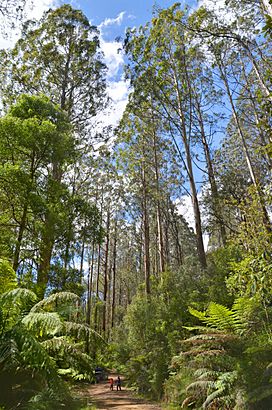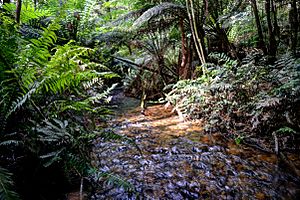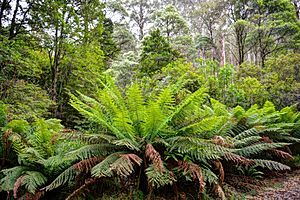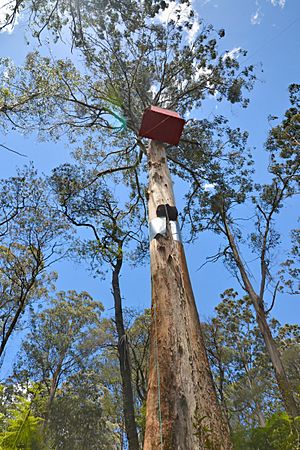Toolangi State Forest facts for kids
Quick facts for kids Toolangi State ForestToolangi |
|
|---|---|

Toolangi State Forest, Yea Link Track
|
|
| Geography | |
| Location | Central Highlands (Victoria), Australia |
| Coordinates | 37°32′15″S 145°30′44″E / 37.53750°S 145.51222°E |
| Elevation | 700 to 100m |
| Administration | |
| Governing body | Department of Environment and Primary Industries (Victoria) |
| Ecology | |
| Indicator plants | Eucalyptus regnans |
| Fauna | Leadbeater's possum |

The Toolangi State Forest is a large forest area in southern Australia, located in the state of Victoria. It stretches from Mount Monda in the south to Murrindindi in the north, and includes the small town of Toolangi.
This forest is mostly made up of Eucalypt trees. Many of these trees have grown back after big bushfires in 1939 and 2009. Some parts of the forest are very old and have never been logged or badly burnt.
Toolangi State Forest is a special place because it is home to the Leadbeater's possum. This small, furry animal is very rare and needs the forest to survive.
Contents
Discover the Kalatha Giant Tree
After the big bushfires in 2009, the people living in Toolangi and Castella wanted to create a special walking path. This path would lead to a huge tree called the Kalatha Giant.
The Kalatha Giant Tree Walk was built with money from the Victorian Bushfires Appeal Fund. A government minister, Mark Butler, officially opened it on July 28, 2013, which is National Tree Day.
The Kalatha Giant is a type of tree called a mountain ash (Eucalyptus regnans). It has a very wide base, almost like roots spreading out. It is the seventh largest tree in Victoria! This amazing tree is 65.5 metres tall and has a huge trunk that is 13.85 metres around.
Fun Activities in Toolangi Forest
Toolangi State Forest is a popular spot for outdoor activities. It's close to Melbourne, so many people visit to enjoy nature. You can go bushwalking, watch birds, ride mountain bikes, or explore the trails with dirt bikes and four-wheel drives.
Explore Walking Tracks
There are many walking tracks in Toolangi State Forest for you to enjoy. Here are a few examples:
- Yea River Walk: This is a loop walk that starts at the Toolangi Visitors' Centre. It's about 4 kilometres long and takes around one hour.
- Sculpture Walk: Another loop walk starting at the Visitors' Centre. It's 3 kilometres long and takes about 45 minutes.
- Wirra Willa Rainforest Walk: This walk takes you through a beautiful rainforest. It's 2 kilometres long and takes about one hour.
- Blue Mountain Ascent: This track offers great views across the Yarra Valley. It's 6 kilometres long and takes about 1.5 hours.
- Tanglefoot Walking Tracks: These are a series of tracks that form a 20-kilometre loop. You can do the whole loop or just parts of it. There's even a boardwalk and a picnic area.
Rare Plants and Animals
Toolangi State Forest is home to many special plants and animals. Some of these are very rare or threatened, meaning they are at risk of disappearing forever.
Threatened Plant Species
Many plant species found in Toolangi State Forest are protected by laws in Australia. Here are some examples:
- Amphibromus pithogastrus, also known as swollen swamp wallaby-grass.
- Astelia australiana, called tall astelia.
- Caladenia concolor, known as maroon spider orchid.
- Caladenia rosella, the rosella spider orchid.
- Eucalyptus crenulata, also called Buxton gum.
- Grevillea barklyana, known as gully grevillea.
- Thismia rodwayi, which looks like tiny "fairy lanterns."
Threatened Animal Species
Several animal species in Toolangi State Forest are also protected. They are important parts of the forest's ecosystem.
- Leadbeater's possum: A very rare and special possum.
- Spot-tailed quoll: A carnivorous marsupial with spots.
- Powerful owl: A large and strong owl.
- Sooty owl: An owl with dark, sooty feathers.
- Masked owl: An owl with a distinctive mask-like face.
Protecting Toolangi Forest from Logging
Logging is when trees are cut down for timber. In Toolangi State Forest, logging is allowed by the government and managed by certain departments. However, many local people are against this logging. They worry it destroys the remaining untouched parts of the forest. These areas are vital homes for the threatened Leadbeater's possum.
In 2011, local leaders from the Yarra Ranges area asked politicians to stop logging in certain parts of the forest, like the Bicentennial Trail and Mt St Leonard.
Legal Action to Stop Logging
A local environmental group called MyEnvironment Inc. took legal action to try and stop logging in some areas of Toolangi State Forest. They argued that logging would harm important forest areas and the homes of Leadbeater's possums.
The court case looked at whether the logging was legal. The judge decided that the logging done before the case started was not against the rules at that time. The judge also said that the logging company had to follow a rule to protect special possum habitats.
The logging company agreed to avoid logging the most important possum habitats and to use a different logging method that would cause less damage. They also promised not to burn the forest after logging in those areas.
Idea for a Great Forest National Park
In 2013, a professor named David Lindenmayer suggested creating a new "Great Forest National Park". This park would cover the mountain forests east of Melbourne, including Toolangi. The idea was to protect these forests from logging.
Professor Lindenmayer explained that logging harms the homes of Leadbeater's possums. He said that logging makes parts of the forest unsuitable for these animals for a very long time. He believes that creating a national park would help save the possums and the forest.
The Little Red Toolangi Treehouse Protest
In November 2013, a protest started in Toolangi State Forest at a place called The Little Red Toolangi Treehouse. A young person named Hannah Patchett moved into the treehouse to protest logging. She was inspired by Professor David Lindenmayer, who wanted logging to stop to help save the Leadbeater's possum from extinction.
Hannah stayed in the treehouse, which was like a small home, hoping the government would announce plans to protect the possum. Later, another young conservationist named Beee Mallia took her place. Beee stayed in the treehouse through all kinds of weather. This protest was a way to bring attention to the need to protect this unique forest.
Images for kids



















